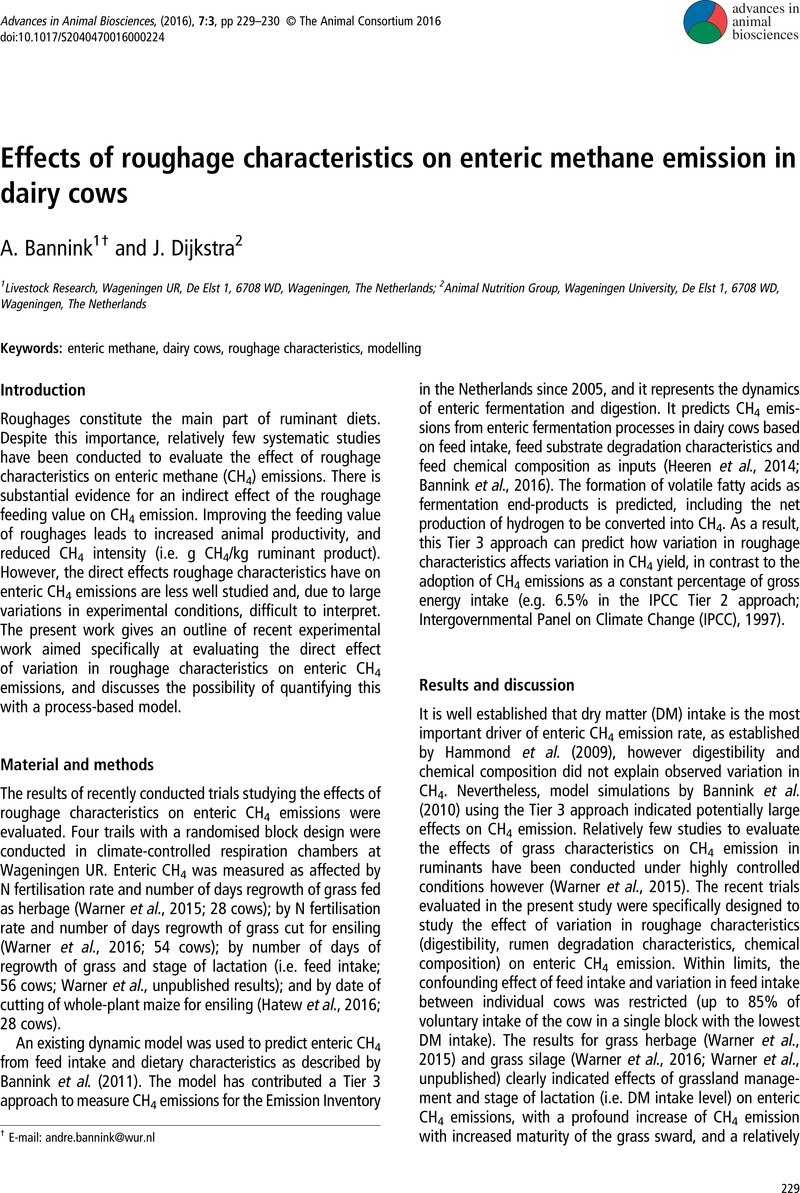No CrossRef data available.
Article contents
Effects of roughage characteristics on enteric methane emission in dairy cows
Published online by Cambridge University Press: 28 October 2016
Abstract
An abstract is not available for this content so a preview has been provided. Please use the Get access link above for information on how to access this content.

- Type
- Full Paper
- Information
- Advances in Animal Biosciences , Volume 7 , Special Issue 3: Proceedings of LiveM 2016: Modelling Grassland-Livestock Systems Under Climate Change , November 2016 , pp. 229 - 230
- Copyright
- © The Animal Consortium 2016
References
Bannink, A, Smits, MCJ, Kebreab, E, Mills, JAN, Ellis, JL, Klop, A, France, J and Dijkstra, J
2010. Simulating the effects of grassland management and grass ensiling on methane emission from lactating cows. The Journal of Agricultural Science
148, 55–72.Google Scholar
Bannink, A, Van Schijndel, MW and Dijkstra, J
2011. A model of enteric fermentation in dairy cows to estimate methane emission for the Dutch national inventory report using the IPCC Tier 3 approach. Animal Feed Science and Technology
166–167, 603–618.Google Scholar
Bannink, A, Warner, D, Hatew, B, Ellis, JL and Dijkstra, J
2016. Quantifying effects of grassland management on enteric methane emission. Animal Production Science
56, 409–416.Google Scholar
Brask, M, Lund, P, Hellwing, ALF, Poulsen, M and Weisbjerg, MR
2013. Enteric methane production, digestibility and rumen fermentation in dairy cows fed different forages with and without rapeseed fat supplementation. Animal Feed Science & Technology
184, 67–79.Google Scholar
Hammond, KJ, Humphries, DJ, Crompton, LA, Kirton, P and Reynolds, CK
2015. Effects of forage source and extruded linseed supplementation on methane emissions from growing dairy cattle of differing body weights. Journal of Dairy Science
98, 8066–8077.Google Scholar
Hammond, KJ, Muetzel, S, Waghorn, GC, Pinares-Patino, CS, Burke, JL and Hoskin, SO
2009. The variation in methane emissions from sheep and cattle is not explained by the chemical composition of ryegrass. Proceedings of the New Zealand Society of Animal Production
69, 174–178.Google Scholar
Hatew, B, Bannink, A, Van Laar, H, De Jonge, LH and Dijkstra, J
2016. Increasing harvest maturity of whole-plant corn silage reduces methane emission of lactating dairy cows. Journal of Dairy Science
99, 354–368.Google Scholar
Heeren, JAH, Podesta, SC, Hatew, B, Klop, G, Van Laar, H, Bannink, A, Warner, D, De Jonge, LH and Dijkstra, J
2014. Rumen degradation characteristics of ryegrass herbage and ryegrass silage are affected by interactions between stage of maturity and nitrogen fertilization level. Animal Production Science
54, 1263–1267.Google Scholar
Intergovernmental Panel on Climate Change (IPCC)
1997. Revised 1996 IPCC Guidelines for National Greenhouse Gas Inventories. Intergovernmental Panel on Climate Change, Bracknell, UK.Google Scholar
Van Gastelen, S, Antunes-Fernandes, EC, Hettinga, KA, Klop, G, Alferink, SJJ, Hendriks, WJ and Dijkstra, J
2015. Enteric methane production, rumen volatile fatty acid concentrations, and milk fatty acid composition in lactating Holstein-Friesian cows fed grass silage- or corn silage-based diets. Journal of Dairy Science
98, 1915–1927.Google Scholar
Warner, D, Hatew, B, Podesta, SC, Klop, G, Van Gastelen, S, Van Laar, H, Dijkstra, J and Bannink, A
2016. Effects of nitrogen fertilisation rate and maturity of grass silage on methane emission by lactating dairy cows. Animal
10, 34–43.Google Scholar
Warner, D, Podesta, SC, Hatew, B, Klop, G, van Laar, H, Bannink, A and Dijkstra, J
2015. Effect of nitrogen fertilization rate and regrowth interval of grass herbage on methane emission of zero-grazing lactating dairy cows. Journal of Dairy Science
98, 3383–3393.Google Scholar




